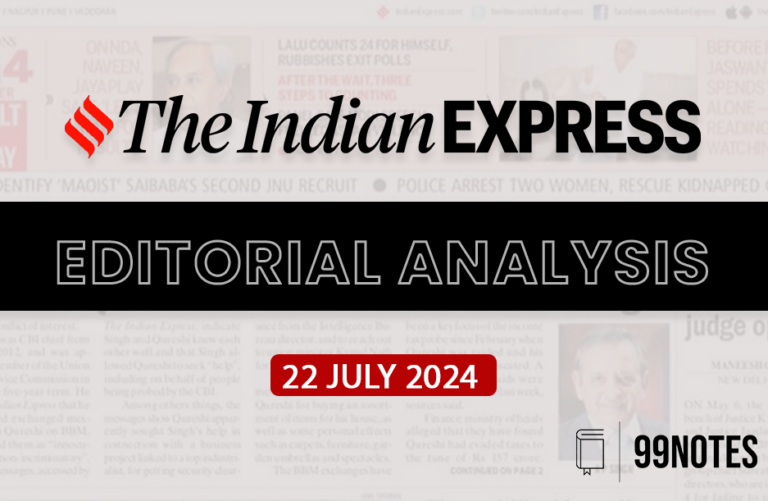25 October 2024 : Indian Express Editorial Analysis
1. An investment, not a waste
(Source: Indian Express; Section: The Editorial Page; Page: 10)
| Topic: GS3 – Agriculture |
| Context: |
| The article discusses the need to reallocate funds from food subsidies to agricultural R&D to boost productivity and ensure food security in India. |
The Need for Enhanced R&D in India’s Agriculture Sector
- India’s agricultural sector urgently requires increased investment in research and development (R&D) to address challenges such as low crop productivity, climate change resilience, and food security.
- Ashok Gulati, a respected agronomist, argues in recent articles that such R&D investment could yield significant long-term benefits. Developing crop varieties that withstand climate stressors and implementing productivity-boosting innovations would support food security and enhance farmers’ incomes.
- In the face of environmental volatility and a growing population, the farm sector must be proactive in adopting technological advancements to maintain and strengthen its foundational role in India’s economy.
Critique of Input Subsidies and Their Consequences
- Gulati contends that India’s input subsidies for electricity, fertilizers, and water contribute to resource inefficiency and environmental harm.
- These subsidies, while intended to make resources affordable for farmers, encourage overuse, leading to soil degradation, depletion of groundwater, and reduced crop diversity.
- By addressing this policy, India could better allocate resources toward agricultural R&D, which may offer more sustainable benefits.
- Realigning subsidy policies to encourage more mindful use of resources would contribute to both environmental conservation and agricultural innovation.
Debating the Proposal to Cut Food Subsidies
- Gulati suggests reducing food subsidies as a means to fund agricultural R&D, arguing that expenditures on food security for consumers directly compete with investments in agricultural development.
- While this perspective seeks a redistribution of funds, it raises concerns over food security impacts on vulnerable populations. The food subsidy, unlike input subsidies, primarily benefits consumers by ensuring affordability for essential grains through the Public Distribution System (PDS).
- The subsidy is thus not a direct agricultural expenditure but an income support mechanism for low-income households, helping them afford other nutritional foods and reducing their food insecurity.
Understanding the Value of Food Subsidies as Social Support
- The food subsidy acts as a modest income transfer for families with limited earnings, providing them with staples like rice and wheat through PDS.
- For a household earning less than Rs. 20,000 monthly, the subsidy amounts to a considerable financial support, valued at approximately Rs. 700-Rs. 800 per month, freeing up resources for other nutritional essentials like pulses and dairy.
- During crises like the Covid-19 pandemic, this support proved essential in sustaining food security. Framing this subsidy as wasteful may overlook its critical role in supporting the health and welfare of India’s lower-income population.
Balancing R&D Investment and Food Subsidies
- Critics argue that expanded PDS coverage under the National Food Security Act (NFSA) has unnecessarily increased subsidies, yet evidence shows that wider PDS access addresses systemic exclusion errors.
- The NFSA raised coverage from 44.5% to 67% of the population, while reducing per capita grain allotments, meaning increased coverage did not lead to substantially higher subsidy costs.
- Given that agricultural R&D has high returns—especially when focused on nutritional foods like pulses, milk, and vegetables—investments in these areas would have widespread health and economic benefits.
- Redirecting funds from other areas, such as production-linked incentives for certain industries, may provide a more balanced approach to increasing agricultural R&D without compromising food security.
Conclusion: A Balanced Approach for India’s Agricultural Future
- Agricultural R&D is critical for ensuring India’s food security and agricultural resilience, but cutting essential food subsidies to fund it may have unintended social costs.
- Instead, restructuring subsidies in a way that addresses inefficiencies without sacrificing food security, or exploring cuts from non-essential subsidies, may offer a balanced approach.
- This strategy would promote technological innovation in agriculture while maintaining essential support for India’s most vulnerable populations.
| Practice Question: Discuss the need for reallocating funds from agricultural subsidies to research and development (R&D) in India’s farm sector to improve productivity, climate resilience, and food security. Critically analyze the implications of reducing food subsidies in this context. (250 words/15 m) |


